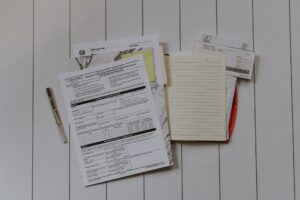Many people don’t think about their credit reports until it’s time to buy a new car or home. But by that point, plenty of red flags could have accumulated to stand in the way of what you want to purchase.
You are not alone if you are unsure how to read a credit report. Many people are intimidated by credit reports and only look at them once they are absolutely necessary. However, examining your credit report is vital to good financial health because it helps you take control of your money and purchasing power. Banks and other financial institutions use credit reports to make lending decisions and allow you to borrow money.
Here are examples of red flags on credit reports and information about disputing credit reports containing errors. The financial professionals at Western Shamrock are here to help you rebuild your credit and get a handle on your finances.
What is a Credit Report?
Credit reports contain financial information from a major credit bureau, Experian, Equifax, or TransUnion. Each of these three credit bureaus collects information on you to report about your payment and borrowing habits.
So, what appears on your credit report? Here’s an overview of what you’ll find while examining your credit report:
- Personal information
- Current and any former names
- Current and past addresses
- Phone numbers
- Social security number
- Date of birth
- Employer information
- Account details
- Account open and close dates
- Payment history
- Late payments
- Accounts in collection
- Credit limits
- Loan amounts
- Public records
- Bankruptcies
- Foreclosures
- Inquiries
- Hard credit checks
- Soft credit checks
How to Access Your Credit Report
Fortunately, getting a copy of your credit report from the three credit bureaus is free and easy. Visit AnnualCreditReport.com once per year to access your credit report at no charge.
You may also be able to get your credit report from a bank, lender, or credit card company. Certain situations can give you access to a free credit report, too. For example, you can get another free copy of your free credit report if you are on welfare assistance or are unemployed and looking for new employment within 60 days. If a lender denies you a personal loan or other type of loan for any reason, you can get a free credit report from the credit bureau that the lender used as a basis for the denial.
How to Read Your Credit Report & Identify Red Flags
Now it’s time to dive into how to read credit reports so that you recognize red flags when they occur. Credit reports are typically divided into the following sections to keep the information organized.
Sections of the Report
- Personal information – carefully check for accuracy
- Summary – check for missed payments
- Consumer statement – review for understanding
- Accounts – ensure all accounts belong to you
- Hard inquiries – identify any inquiries you don’t recognize
- Collection accounts – look for collection agencies you don’t recognize
- Public records – verify the information is correct
Report Summary
At the top of a credit report, you’ll typically see a summary of all the following information: the report date, average account age, length of credit history, and red flag accounts with potentially negative marks.
What does potentially negative on credit report mean?
Accounts with past-due payments or those that have gone into collections are listed as potentially negative. This is an adverse designation from a credit reporting company to draw a reviewer’s attention to possible financial issues. What appears on your credit report provides additional details about the accounts concerned. Negative marks on a credit report can last for two to 10 years.
Common Red Flags on Credit Reports
After reviewing the summary section, are there any details that don’t seem right, such as a missed payment you don’t remember missing? Now is the time to take a closer look at those sections of the report and file a credit report dispute if appropriate.
Incorrect Personal Information
Credit reports may have inaccurate information about you, such as an outdated address, phone number, or employer. A mistake in your name, address, or social security number could indicate identity theft. A credit bureau will investigate potential fraud if your names or numbers are wrong.
Recent Credit Card Applications
Another red flag on credit reports involves multiple new credit card accounts added in a short period of time. Look for accounts you do not recognize and the payment history to determine if you disagree with what’s listed on the report.
Maxed Out Credit Cards
Maxed-out cards are red flags because they show high credit utilization ratios and potential financial instability if you only make the minimum monthly payments.
Cash Advances on Credit Cards
Lenders may view cash advances as risky behavior and deny loaning you money. Even though they might get you by financially in a pinch, they can also hurt your credit score and credit utilization.
Accounts Sent to Collections
Accounts in collections impact your credit score, but it’s also essential to monitor unfamiliar debts to prevent identity theft. Look for accounts marked as closed but show up on your report as in collections. One of your accounts could have been sent to collections, but you don’t even know about it. You might find utility and cell phone bills here and unpaid bills for subscription services.
Cosigning Loans
Cosigning a loan means taking on the debt responsibility for another person who might otherwise have trouble borrowing money or accessing services. A certain level of risk is associated with the primary borrower’s spending, which could affect you as the cosigner.
Short Sales on Previous Homes
A short sale occurs when a lender accepts less than what’s due on a mortgage in lieu of foreclosure or bankruptcy. There are certain red flags that lenders can recognize on a credit report indicating the entire mortgage was not paid in full, therefore negatively affecting your credit.
How to Dispute Errors on Your Credit Report
Now that you understand how to read a credit report, learning about disputing credit reports is important.
First, identify inaccuracies in your report and file a dispute with the relevant credit bureau – Equifax, Experian, or TransUnion. Choose online dispute resolution systems for the fastest service and efficiency when possible. If the same error appears on more than one credit bureau report, you must file a dispute with each bureau.
Credit bureaus take up to 30 days to investigate claims and respond to disputes. After filing a credit report dispute, follow up on it and track the progress of the resolution so that it doesn’t fall between the cracks.
Who Can Access Your Credit Report?
The Fair Credit Reporting Act outlines who can access a person’s credit report and for what purposes. Organizations can request them from reporting agencies to make decisions about insurance, credit, employment, and loans.
However, as an individual, you do not necessarily have to give permission to a company to review your credit report. How organizations can use your credit report varies by state. For example, in some states, employers can review credit reports as part of the hiring and promotion processes, but this isn’t the case in all states. There are also limitations on how insurance companies can use credit reports to offer policies in some states.
Credit Scores vs. Credit Reports
Two of the most important pieces of personal financial data are credit reports and credit scores. Credit scores are primarily based on the data in your credit report. Credit reports provide more detailed information about your credit history, while the scores only offer a limited view based on certain parts of the reports.
Creditors use different credit scoring models to assess applications. Using a different model will result in a different credit score even while pulling information from the same credit report. For instance, your personal information does not affect your credit score with the VantageScore and FICO Score models but may affect other models.
You must closely monitor your credit report, so your credit score is not impacted. A lower credit score can make it more difficult to get a loan or credit card, plus it can result in higher interest rates if you are approved.
How to Avoid and Overcome a Red Flag on Credit Report
As you can see, regularly examining your credit report is one of the best ways to secure your financial situation. Promptly and proactively disputing errors in credit reports is highly recommended to avoid unnecessary hardship and protect your identity.
Fortunately, there are ways to bounce back from red flags on credit reports and improve your credit moving forward. For example, you can make all credit card payments before they are due, use your credit card less, and file a credit report dispute if something is wrong.
Also, consider a credit-builder loan to show lenders that you are a responsible borrower. Western Shamrock can assist you with this type of installment loan to help you build your credit history and potentially improve your credit report for future financial stability.








